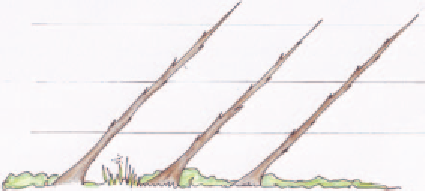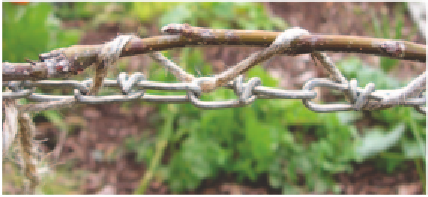Agriculture Reference
In-Depth Information
Table5.2 Applesandpearsbestgrownasfree-standingtrees
Some apples and pears are not suited to espalier as they fruit on
branch tips as well as spurs. If the tips are cut back the tree will
have a reduced harvest. The following varieties are best grown as
free-standing trees (see pages 126-132).
Apples - Jonathon, Granny Smith, Golden delicious
Pears - Williams (syn. Bartlett)
Supportandtrellis
Select your tree and ensure you have the
cultivar you require, ideally on a dwarfing
rootstock (see page 125). If you can choose
how to orientate your espalier to the sun, a
trellis on open ground running north-south
will allow maximum sun and air flow to both
sides of the tree. If it is being trained against a
wall, choose a north-facing one in the
southern hemisphere, or a south-facing wall in
the northern hemisphere for maximum fruit.
Figure 5.13
'Ballerina' apples make for easily-trained
cordons that can be combined to create garden dividers.
continue to favour the uppermost parts of
the tree, at the expense of the lower
branches. An effective espalier needs to be
clothed evenly from top to bottom, so
avoiding vertical growth, and a central
leader, makes training much easier.
A variation of a central leader, often
called a cordon, is successful with fruits
that bear on small outgrowths called spurs,
such as apples and pears (see Table 5.2).
It is always advisable to train these at an
angle to minimise apical dominance (see
Figure 5.13).
Once you have decided on your design, erect
the trellis or mark out a wall or fence while
the passion is upon you.
A free-standing trellis using solid uprights
well sunk into the soil, and fencing wire or
chain strung at intervals where you want to
train your mother branches is the simplest
construction. Using lightweight chain
instead of wire makes it easier to attach
plant ties as they can be anchored on a link,
rather than free-wheeling along a wire
(see Figure 5.14).
A variant of this method can be combined to
create a Belgian fence, perhaps the most
elegant of garden dividers (see Figure 5.3).
Suit your design to the type of fruit you are
growing (see Table 5.1). There is vast scope
for creativity when designing your espalier.
All you need to do is to keep in mind the
natural laws of growth outlined on
pages 1-7.
Table 5.1
Fruit trees suitable for espalier training
Horizontaltraining
Apples, pears, medlars, quince and European plum
Fantraining
Japanese plums, sour cherry, almond, nectarine/peach, fig
and quince, persimmon
Figure 5.14
Using chain rather than wire makes ties stable.























